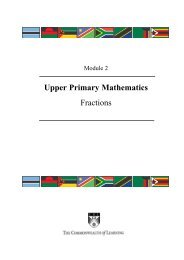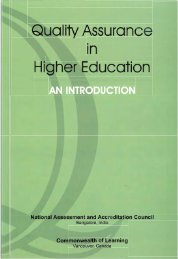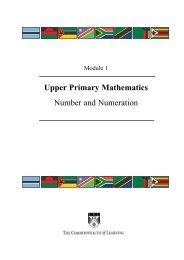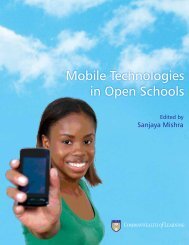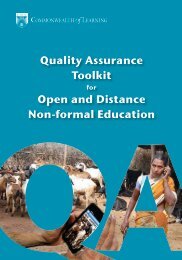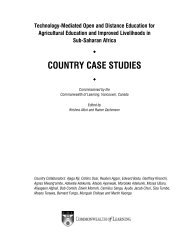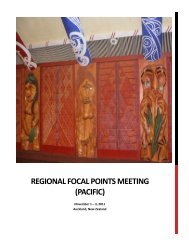unit 6:curriculum implementation - Commonwealth of Learning
unit 6:curriculum implementation - Commonwealth of Learning
unit 6:curriculum implementation - Commonwealth of Learning
Create successful ePaper yourself
Turn your PDF publications into a flip-book with our unique Google optimized e-Paper software.
�<br />
�<br />
Informal Curriculum<br />
Urevbu (1985: 3) refers to informal <strong>curriculum</strong> as the<br />
<strong>curriculum</strong> in use. Teachers or instructors may not adhere to<br />
the presented formal <strong>curriculum</strong> but can include other aspects<br />
<strong>of</strong> knowledge derived from other sources. This additional<br />
material is called the ‘informal <strong>curriculum</strong>’.<br />
Actual Curriculum<br />
This refers to both written and unwritten syllabuses from<br />
which students encounter learning experiences (Tanner and<br />
Tanner 1975). <strong>Learning</strong> experiences can be selected from other<br />
sources rather than the prescribed, <strong>of</strong>ficial and formal<br />
syllabuses. The actual <strong>curriculum</strong> is the total sum <strong>of</strong> what<br />
students learn and teachers teach from both formal and<br />
informal curricula.<br />
Self-Assessment 1<br />
Which type <strong>of</strong> assessment covers:<br />
1. knowledge from sources outside the <strong>of</strong>ficial <strong>curriculum</strong>?<br />
2. the contents <strong>of</strong> the <strong>of</strong>ficial syllabuses?<br />
3. content from both the <strong>of</strong>ficial and un<strong>of</strong>ficial syllabuses?<br />
Hidden Curriculum<br />
Urevbu (1985: 3) describes the hidden <strong>curriculum</strong> as the nonacademic<br />
but educationally significant component <strong>of</strong> schooling.<br />
Tanner and Tanner (1995) prefer to call it the ‘collateral<br />
<strong>curriculum</strong>’. They argue that the word ‘hidden’ implies<br />
deliberately concealing some learning experiences from<br />
students. Since this is not written or <strong>of</strong>ficially recognised, its<br />
influence on learning can manifest itself in students’ attitudes<br />
and behaviour, both during and after completing their studies.<br />
What is acquired or learned from hidden <strong>curriculum</strong> is usually<br />
remembered longer than information learned at school. Tanner<br />
and Tanner (1975) recommend that positive learning from the<br />
hidden <strong>curriculum</strong> should be acknowledged and treated as an<br />
integral part <strong>of</strong> the planned and guided learning experiences.<br />
As already implied, the hidden or collateral <strong>curriculum</strong> is <strong>of</strong>ten<br />
responsible for the values students may exhibit later in life.<br />
Relationships between Types <strong>of</strong> Curricula<br />
The relationship between the different types <strong>of</strong> curricula is<br />
shown in the diagram below.<br />
Module 13, Unit 2: Types <strong>of</strong> Curricula 18



